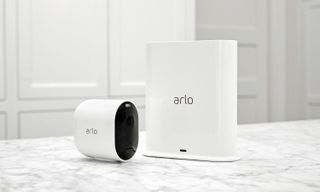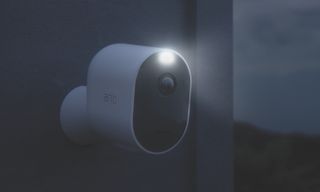Arlo Pro 3 Security Camera vs. Arlo Pro 2 and Arlo Ultra
Arlo’s wireless security cameras compared

Arlo already makes some of the best home security cameras, and its newest addition, the Arlo Pro 3, looks to give consumers yet another option. The Arlo Pro 3 records video at a resolution of 2K and offers color night vision, a built-in light and a built-in siren. Available for $499, the Arlo Pro 3 is neither the least nor the most expensive security camera in Arlo’s lineup. Here’s how this new addition compares to the Arlo Pro 2 and the Arlo Ultra.
Arlo Pro 3 Price and Availability
The Arlo Pro 3 will come in a kit with two cameras and the Arlo SmartHub for $499. Additional Pro 3 cameras will cost $199 each. The Pro 3 will go on sale this week at Best Buy and Arlo.com, and will be available at other retailers by the fourth quarter of 2019.

Arlo Pro 3 Specs vs. Arlo Pro 2 and Arlo Ultra
We’ve previously compared the Arlo with the Arlo Pro, Arlo Pro 2, and Arlo Ultra; here’s how the Arlo Pro 3 stacks up against the Arlo Pro 2 and the Arlo Ultra.
| Header Cell - Column 0 | Arlo Pro 3 | Arlo Pro 2 | Arlo Ultra |
|---|---|---|---|
| Price (2-camera kit) | $499 | $324 | $599 |
| Additional camera price | $199 | $144 | $299 |
| Video Resolution | 2K | 1080p | 4K |
| Field of View | 160 degrees | 130 degrees | 180 degrees |
| HDR | Yes | No | Yes |
| Night Vision | Color | Black and white | Color |
| In-camera Siren | Yes | No | Yes |
| LED Spotlight | Yes | No | Yes |
| Audio | Full Duplex | Half Duplex | Full Duplex |
| Arlo Smart subscription trial | 3 months | None | 1 year |
Video Quality
Specs-wise, the Arlo Pro 3 falls right between the Ultra and the Arlo Pro 2: It has a resolution of 2K (2560 x 1440), and a 160-degree field of view. Like the Arlo Ultra, the Pro 3 has HDR as well as color night vision, two features not in the Arlo Pro 2. However, the Arlo Ultra has a 180-degree field of view, which is 20 degrees wider than the Arlo Pro 3.
Because of their higher resolution and newer processors, the Arlo Pro 3 and Ultra also have motion-tracking and 12x zoom capabilities, meaning the cameras can digitally zoom in on a subject as they move across the frame.
Audio Features
Like the Ultra, the Arlo Pro 3 has full-duplex audio — you don’t have to wait for a subject in front of the camera to stop speaking before you can start — and, thanks to dual microphones, both have noise cancellation, which helps reduce wind and rain noise.

Security Features
The Arlo Pro 3 has a built-in spotlight, just like the Ultra. While not as powerful as Ring’s Floodlight Cam, the Pro 3’s 6500K, 42 Lux LED can offer some illumination on dark nights. Also like the Ultra, the Pro 3 has a siren in the camera itself; the Arlo Pro 2 has a siren, but it’s in the base station.
Sign up to get the BEST of Tom’s Guide direct to your inbox.
Upgrade your life with a daily dose of the biggest tech news, lifestyle hacks and our curated analysis. Be the first to know about cutting-edge gadgets and the hottest deals.
Arlo Smart Subscription
Included with the Arlo Pro 3 is a free three-month trial of Arlo Smart, the company’s cloud-storage service, which also gives subscribers additional features such as people, vehicle, animal, and object detection, custom activity zones, and e911 services. Arlo Smart costs $29 per year per camera and gives you 7 days of rolling cloud storage.
The Arlo Ultra comes with a year of Arlo Smart Premier ($99/year for up to 10 cameras), which has all the benefits of Arlo Smart, but gives you 30 days of rolling cloud storage and unlimited customer support.
If you choose not to pay for any of Arlo’s Smart subscription plans, you still get 7 days of rolling cloud storage for free, which is a pretty good deal when compared with other security camera cloud storage plans.

Michael A. Prospero is the U.S. Editor-in-Chief for Tom’s Guide. He oversees all evergreen content and oversees the Homes, Smart Home, and Fitness/Wearables categories for the site. In his spare time, he also tests out the latest drones, electric scooters, and smart home gadgets, such as video doorbells. Before his tenure at Tom's Guide, he was the Reviews Editor for Laptop Magazine, a reporter at Fast Company, the Times of Trenton, and, many eons back, an intern at George magazine. He received his undergraduate degree from Boston College, where he worked on the campus newspaper The Heights, and then attended the Columbia University school of Journalism. When he’s not testing out the latest running watch, electric scooter, or skiing or training for a marathon, he’s probably using the latest sous vide machine, smoker, or pizza oven, to the delight — or chagrin — of his family.
